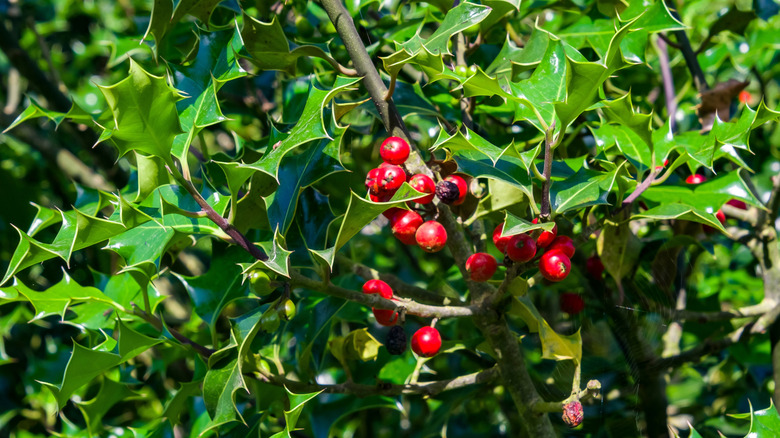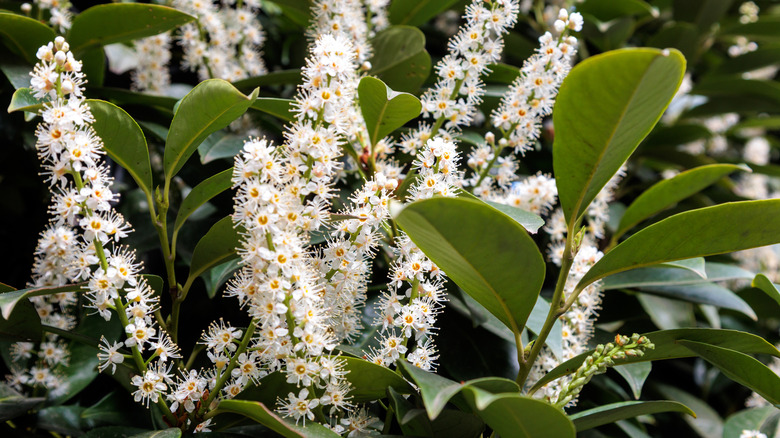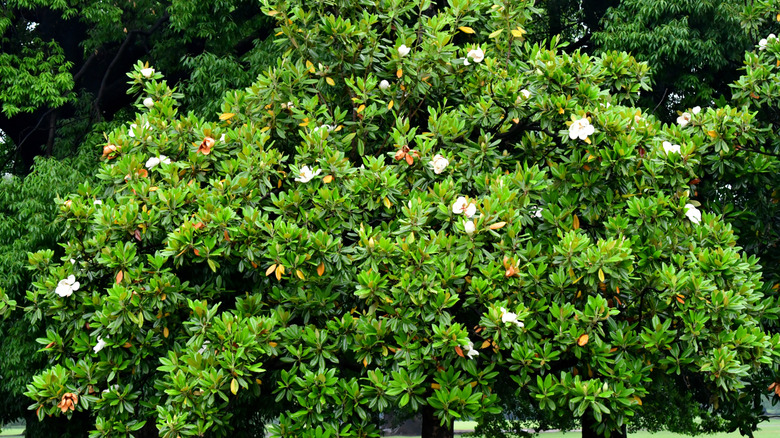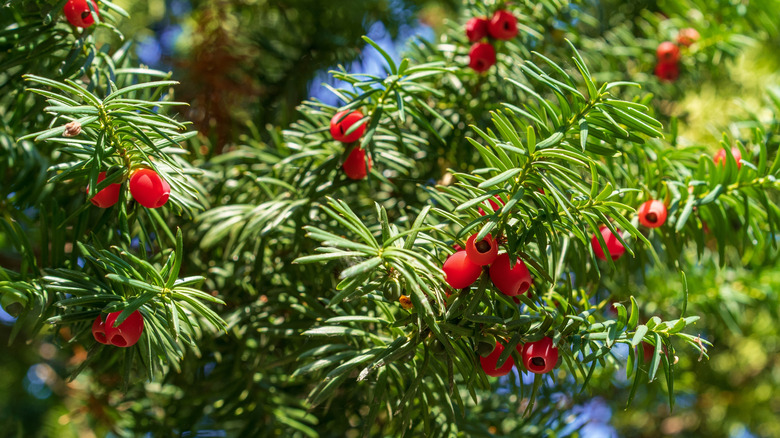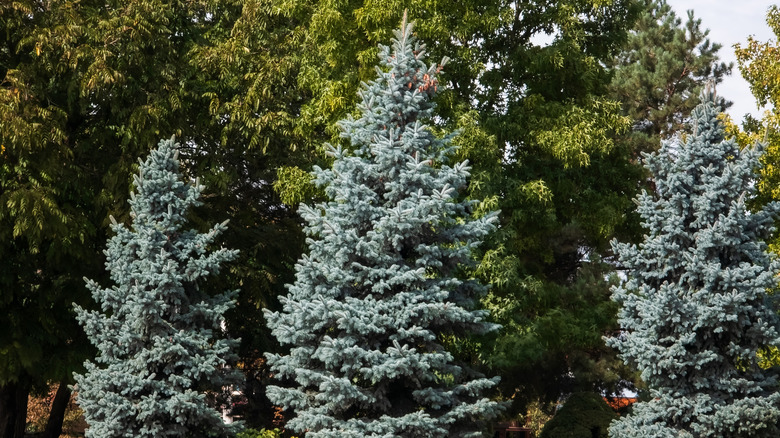The 9 Best Plants To Get In The Ground During Fall For Natural Privacy
After a hectic growing season in the garden spent carefully watering, deadheading, and generally tending to your summer bloomers, avid gardeners can find themselves at something of a loss when the fall rolls around. However, there are still plenty of things that you can do to keep you busy when the rest of your garden starts to fall fallow. Especially in exposed areas, it can be a great time of year to think about screen planting. Screen plants can also help to provide shade, depending on the height of your chosen plantings. They can block your yard from the eyes of passers-by, as well as those of any neighbors who appear to have taken an interest in your outdoor comings and goings.
As for which varieties to plant at this time of year, generally speaking, those that are about to enter their annual dormancy phase are the best. In the context of trees and bushes, the period of dormancy is when they're least likely to channel energy into leaf or flower production. In other words, by planting varieties that are either in this state, or about to be, you can ensure they have the best chance possible to establish their roots ahead of the next growing season. And the specific species? Well, that's the exciting part. There are so many to choose between, from evergreen conifers to a couple of deciduous options that can offer summertime privacy in outdoor areas without stealing valuable sunlight in winter.
Green giant (Thuja standishii × plicata 'Green Giant')
The name alone should give you a clue of what to expect from this gorgeous conifer. Known and loved by gardeners in need of a fast-growing tree for backyard privacy, this particular species can reach heights of more than 50 feet. What's more, depending on your screening needs, one tree can be planted alone, or you can grow them in rows to form hedges. Strictly speaking, the green giant is an evergreen. However, you shouldn't expect it to remain "green" throughout the year. But don't worry, it'll still put on a show. In the winter, its foliage turns a spectacular shade of bronze, which is superb for keeping things colorful when the summer bloomers have long been laid to rest. It can be grown in most landscapes, too, tolerating a range of soil conditions and climates. Having said that, it's best suited to hardiness zones 5 to 9, where conditions are optimal for speedy growth.
As for when to plant it, it's best to hold off until the autumn. Like most conifers, green giants are best planted during their dormant phase — when they can channel most of their energy into root establishment. If you plant your tree when all it wants to do is foliate, you risk putting undue stress on your sapling.
Leyland cypress (Cupressus x leylandii)
Leyland cypress (Cupressus x leylandii) is perhaps the best kind of cypress tree for a privacy fence, as it promises to form an effective barrier in your yard in double time. What's more, these trees can last anything between 15 and 20 years or more, meaning that once they're in and established, you won't need to worry about your boundaries for potentially decades. However, considering where you'll plant them is key. Bright, sunny spots tend to be best, and try to hold off until the fall to put your saplings in the ground. At this time of year, natural rainfall will keep them watered well enough to help the roots anchor themselves. They'll also be gearing up for their annual dormancy phase, meaning they can focus all their energy on root establishment.
Provided that you take care when planting them, you'll be amazed by how much privacy these gorgeous growers provide. Placed between 12 and 15 feet apart (and at least 15 feet away from structures), these trees will quickly fill in the gaps. In fact if left to do their own thing, they're more than capable of exceeding 70 feet in height, which ought to deter any nosy neighbors from peeking over the fence. They grow with blue-green foliage, which residents on either side of the boundary are sure to love, and since they're evergreen, they'll continue to delight all involved throughout the winter.
English holly (Ilex aquifolium)
The first thing to note before you go ahead and plant yourself some English holly (Ilex aquifolium) is that, in some states, including California, Oregon, and Hawai'i, this tree is considered invasive. If you live in these areas, or parts of the Northeast and Alaska, then you should look for another type of tree, as English holly, being shade-tolerant and fast-growing, can quickly get out of hand and become more of a problem than a welcome source of privacy.
Elsewhere, however, these bushes can be an excellent choice for screening. They'll shower your garden with flecks of berry red in the winter, and thanks to broadleaf, dark green foliage, they'll continue adding interest to your garden when your garden's summer-flower show comes to a close. They're also tall, growing up to 30 feet. To successfully care for your holly, try to give it a spot with at least partial sun and where it's unlikely to dry out. If you can manage that, they'll grow just fine, especially if you plant them in the autumn during their dormant phase, which will allow their roots plenty of time to get acquainted with the ground.
Cherry laurel (Prunus laurocerasus)
Blooming with pendulous white and fragrant flowers in the spring, Cherry laurel is renowned for its hardiness, and will rapidly spread if afforded reasonable conditions. However, in some states, including Oregon and Washington, as well as parts of the Southeast and Mid-Atlantic, its fast-growing tendencies and ability to be spread by birdlife can cause even the most contained planting scheme to quickly get out of hand, so check your local agricultural extension to determine if it's safe to plant in your area. However, if you live elsewhere, and are able to install boundaries in your garden to prevent it from spreading too much, it's a fantastic choice for screening.
Cherry laurel trees are evergreen, which means they promise to keep the show going throughout the otherwise barren winter months. They're winter hardy in zones 6 to 8, and if planted in those zones, can grow surprisingly quickly, which is great for those who want a speedy solution to privacy. Just be sure to plant them in the autumn. By this time, your trees should have stopped growing for the season, meaning they can channel their energy into anchoring their roots. Finally, while these trees are not particularly fussy about the soil in which you home them, they're unlikely to reward you with abundant, bushy growth if the ground frequently becomes waterlogged.
Southern magnolia (Magnolia grandiflora)
Part of the magnolia family and known for its beautiful and large white flowers, this particular tree can grow up to 80 feet tall and spread up to 40 feet, which means that you'll need to provide it with plenty of growing room. Late in the fall is a good time to plant it, as by this stage it's likely to be dormant, meaning it can focus its energy on establishing its roots rather than foliating. And if the autumns and winters in your area are usually dry, then try to keep your new tree well-watered, continuing to do so between six and 12 months after transplanting.
What you'll love about this magnificent evergreen is that, despite its potential to grow and spread, it has a surprisingly compact growth pattern, which makes it a natural ally for those hoping to block out prying eyes. More than that, it's surprisingly versatile and will grow both happily and hardily in between zones 6 and 10. Even if you need something slightly smaller-growing, there are plenty of cultivars available that are better-suited to smaller spaces. These include the cutely-named 'Teddybear,' which usually maxes out at around 20 feet in height while spreading up to 12.
English yew (Taxus baccata)
With dense, evergreen foliage, English yew (Taxus baccata) is one of several evergreens that promise privacy all year round. Unlike other conifers, which tend to grow exposed seeds via cones, English yew produces red, berry-like fruits, which sort of look like a cross between a cherry and an olive. Unfortunately, while beautiful, these berries can be toxic, meaning that yew should be planted with caution in gardens where children or pets are likely to find them.
Left to its own devices an English yew can reach heights of up to 25 feet, although, if you want to enjoy its most showy growth, it's best to plant these trees between zones 5 and 7. It's also strongly advised to plant them in the autumn. Like the other trees featured, English yew goes dormant during the fall, which means that its focus on foliage decreases at this time. Finally, to achieve the maximum amount of privacy, try to plant these plants in a row, with one every 1½ to 2 feet. You may have empty spaces when you first transplant them, however, once established, these virulent, vigorous growers will quickly close up the gaps.
American hornbeam (Carpinus caroliniana)
While not an evergreen, American hornbeam (Carpinus) is nevertheless a stylish idea for adding privacy to your yard. It's well suited to areas where summer privacy is essential for outdoor entertainment, but which don't receive much use in the winter. However, despite being deciduous, this native tree can still provide some privacy in winter, thanks to an unusual attribute called "marcescence." Instead of dropping all of its leaves during fall, hornbeam trees are apt to hang on to some of their dead foliage. Paired with the silvery gray limbs, this can provide some residual privacy, while letting a little extra sunshine through into your yard. Just note that they may need to be "pleached" — a process by which trees are trained to grow around a frame — which will help to keep it from becoming unruly.
Planting your hornbeam is best done ahead of the growing season. In other words, aim to get yours in the ground during the autumn, as this is when it's best able to establish its roots in your soil. Once it's in, you can expect reliable, and more importantly, abundant growth. In fact hornbeam is capable of reaching over 20 feet in height and up to 35 feet in width, and while it affords the most leafy privacy during the summer, it's nevertheless worthy of wonder during the winter, thanks to the fluted, slate-gray bark that encases its trunk and limbs.
Blue spruce (Picea pungens)
Well-suited to the cooler climes of zones 3-7, when planted approximately 20 feet apart, blue spruce (Picea pungens) can bring dazzling interest and natural privacy in equal measure to gardens, especially those that are tended by lovers of the festive season. They look like quintessential Christmas trees, and while you'll be tempted to pull one out when the time comes to deck the halls, you should consider leaving it in the ground. If left to grow, this most beautiful of spruces can reach up to 60 feet in height, flushing your garden with foliage that ranges from silvery-blue to bluish green. And while it's unlikely to reach such heights overnight, this slow-grower has the potential to provide excellent visual and sound insulation. It'll also buffer your garden against the wind, making it perfect for gardens in more exposed areas.
As for when you should plant blue spruce, autumn is generally ideal. Being one of the best trees to plant during the dormant season, the milder temperatures of fall can help blue spruce to form new roots. More than that, at this time of year the soil should still be workable. You'll need to dig a hole both twice as wide and twice as deep, as your tree's rootball, and while you could technically plant it during the winter, you're likely to regret waiting until the ground starts to freeze.
October Glory Maple Tree (Acer rubrum 'October Glory')
Commonly known as "red maple," October glory maples (Acer rubrum 'October Glory') are one of the best trees for adding value to your home. They make excellent additions to gardens in hardiness zones 4 to 9, especially those that could use a little extra privacy, but which benefit from some added sunshine in winter. They're deciduous, which means that they will spill their leaves onto the ground once a year. It also means that they're better suited to spaces in your yard that need summer and autumn privacy, but where it's not as important in the winter, such as a grilling area or pool. Additionally, opting for a screen of red maples can be the perfect choice for east-, west-, or south-facing perimeters where you want summertime privacy but don't wish to sacrifice too many of those precious winter sun rays filtering into your yard.
Before they drop their leaves, however, these particular trees promise a dazzling display (as the name suggests) of glorious reds, adding interest to fall gardens at a time when they need it the most. During the growing season, dense foliage provides ample privacy, especially when they reach their full potential of up to 50 feet in height and a spread of 35 feet. Planting your October glory in the fall will allow the roots plenty of time to settle ahead of the next growing season. Like most trees, they need plenty of energy to assist as they anchor their roots into the ground, and if planted during the summer, you risk stressing your new tree unnecessarily.



